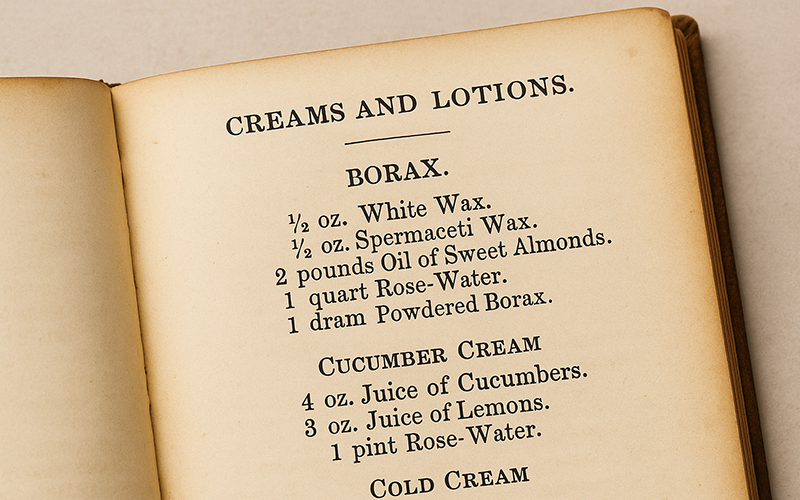Borax (sodium borate) and boric acid have been part of cosmetic formulations for well over a century. If you browse vintage cosmetic recipes, you’ll find them showing up as preservatives, emulsifiers, and pH adjusters. In the 1980s, borax was still common enough that the Cosmetic Ingredient Review (CIR) panel undertook a detailed safety review.
At that time, the panel concluded borax and boric acid were safe in cosmetics at concentrations up to 5%, provided they weren’t used on infants or on broken skin. This conclusion reflected the best science available then—and it matched the long-standing history of use.
So in 1983, the overall picture was that borax was a practical, acceptable cosmetic ingredient.
But science moves forward. Today, borax is under much more scrutiny, especially in the European Union, where it is no longer allowed in cosmetics. Let’s look at where things stand now.
What’s Changed Since 1983
In the decades since, additional research has raised concerns about borates. Animal studies reinforced the link between boron exposure and reproductive toxicity. Regulatory bodies outside the U.S. took a cautious stance:
- European Union — Sodium borate and boric acid are classified as reprotoxic substances and are banned in cosmetics.
- Canada and other jurisdictions have taken a similar restrictive approach.
- California has banned borates in cosmetic products, and New York has introduced legislation to do so.
Meanwhile, the CIR has reopened reviews of many older ingredients, including borates, to reconsider earlier safety decisions in light of new data.
The U.S. Position Today
In the United States:
- Borax is still allowed as a cosmetic ingredient, provided the product is safe for its intended use.
- It is not permitted as a color additive.
- Products must list it in the ingredient declaration as Sodium Borate or Boric Acid.
There are no explicit concentration limits in U.S. regulations, but responsible formulators should respect the CIR’s 5% guideline—and keep in mind that regulators are watching ingredients with potential reproductive toxicity concerns more closely.
Remember also, that new laws from MoCRA require that you have scientific safety substantiation for your cosmetic product and it’s ingredient. That may be difficult if your product contains borax .
Why Many Makers Choose Alternatives
Even though borax is technically still allowed in U.S. cosmetics, most cosmetic makers (large and small) avoid it today. Reasons include:
- Global compliance — if you ever want to sell in Europe, products with borax won’t pass.
- Consumer perception — customers today recognize borax as a laundry additive, not as a skincare ingredient.
- Safer options — modern preservatives and pH adjusters are more effective, better studied, and generally safer.
Still a Workhorse in Other Uses
Borax hasn’t disappeared from shelves. It remains a staple in cleaning products—laundry boosters, household cleansers, and other non-contact uses. In that context, it’s valued for water softening, odor control, and cleaning power.
If you make a laundry detergent there is no reason why borax needs to be avoided.
Final Thoughts
Borax was once a respected cosmetic ingredient, and in 1983 it was judged safe in small amounts. But times have changed: the EU now bans it in cosmetics, safety concerns have grown, and there are plenty of better alternatives.
If you’re formulating in the U.S., borax may still be legal—but for most cosmetic makers, it’s not the best choice. When safer, globally compliant, and consumer-friendly options exist, borax belongs in your laundry soap, not in your lotion or cream.


Leave a Reply